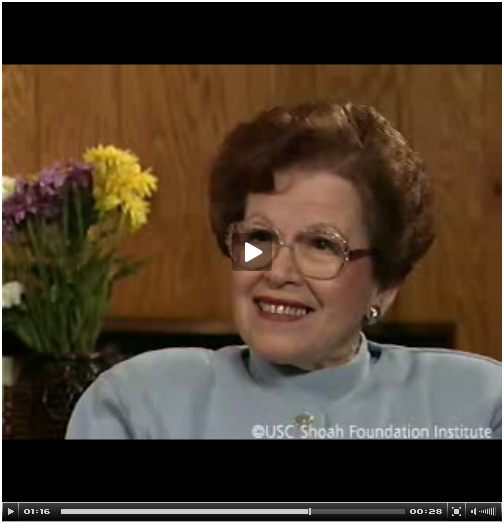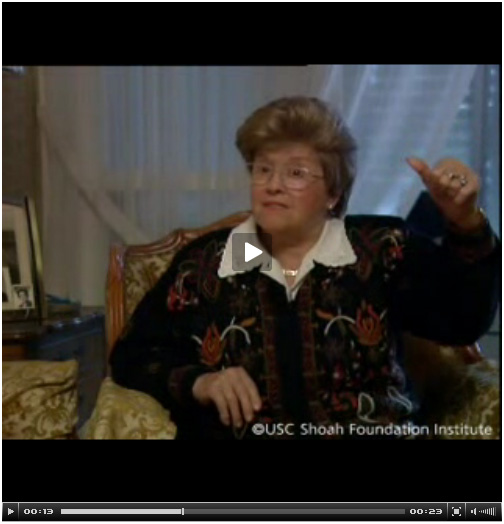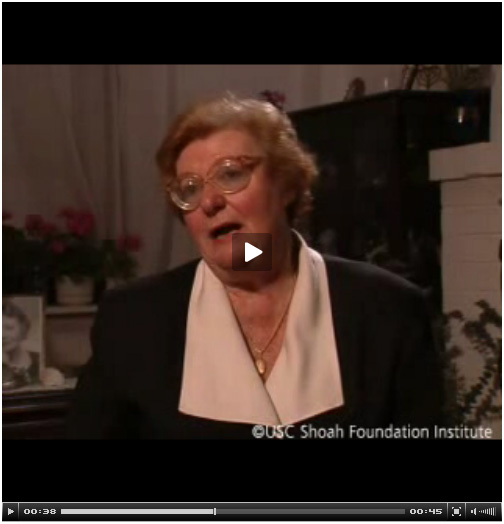The concentration camp diary is a phenomenon that by its very nature can be called unique. While many people who went through camps kept diaries few of them were preserved, though sometimes the diary would be the only trace of a person perished in the concentration camps. Generally, people cherished not only their own writings but also the writings of others. A VHA interviewee who participated in the partisan movement in Ukraine tells of a couple of instances when he would return to pick up his diary even though it involved risking his life. Moreover, a soldier from his regiment once rode back many kilometers to locate his bag containing his notebook.[*] The very act of writing ensured that the person would be preserved in people’s memory even if he or she did not survive the war. The Brisebois collection holds an even more unique set of documents, including self-made cookbooks, armband, and the diary that a prisoner of Kleinmachnow (Klein Machnow) and Ravensbruck camps kept during the death march of April and May 1945.[*] Irena Matusiak (Kuczyk), a young girl at that time, wrote down her experiences, and this simple and short text provides us with the most genuine picture of horrors and hopes of a person placed into these horrendous conditions.
Kleinmachnow, a subcamp of Sachsenhausen concentration camp, was established in the summer 1944 on the outskirts of Berlin, and was designed entirely for female prisoners. The camp was situated on the premises of the Dreilinden Maschinenbau GmbH, a branch of the Bosch Corporation. After the Warsaw uprising, in September and October 1944, about 800 women, were first brought to Ravensbrück, and then transferred to Kleinmachnow. The factory was surrounded by the dense forest that served as camouflage. The prisoners worked in 12-hour shifts producing details for aircraft engines (fuel injections, pumps, and starters). The history of Kleinmachnow was barely known both to later researchers as well as to the contemporary town residents who “did not know that there had ever been a camp there, and that women prisoners had worked there.”[*] In 2002, Angela Martin published a book “Ich sah den Namen Bosch.” Polnische Frauen als KZ-Häftlinge in der Dreilinden Maschinenbau GmbH (Metropol, 2002), in which she gathered accounts of 45 survivors of the camp, including Irena’s story “Als würden wir in die Hölle hinabsteigen” (As we were descending into the inferno). Thanks to this testimony, Irena’s documents can be placed into a specific historical context.
Irena Matusiak (born in 1921) resided in Warsaw, in the Ochota neighborhood with her parents and younger sister. After the Warsaw uprising, the Nazis conducted the mass arrests of city residents, and many people were either killed or deported to the various concentration camps. Irena’s family, including her older sister and a child, was deported to Zieleniak, a marketplace that the SS turned into the transit camp where the future forced workers were collected. Irena recalls how while being there she had the ominous task of dragging away and burying the corpses. From there they were transferred to Pruzków, also a large transit camp created for the deportees from Warsaw and its outskirts.[*] The next day Irena and her younger sister were separated from their family:
A soldier came up, pointed his bayonet at me and said “You, criminal!” I had to follow him. My younger sister wanted to take some things from me for my older sister’s child but the soldier did not let her go and thus we remained together. [*]
They were taken to Bergen-Belsen, stayed there for a week and afterwards were selected to go to Ravensbrück[*] This happened by the end of August 1944. Irena notes that the entrance into Ravensbrück gave her the most horrifying impressions, shared by the majority this camp’s survivors:
The most indelible memory I have is the moment of arrival in the camp in Ravensbrück. As a child I always had a sort of childish picture of how I imagined hell and, suddenly, there it was. An arched iron gate opens upwards, clanging and grating. Red lights of some sort. Night. And there we are, entering a black abyss. Pushed and shoved, we fall over each other. I had the feeling that we were descending into hell.
Irena spent about a month there, and afterward, in early September 1944 men from the factory arrived and selected the ones fit to work: “There were SS-men and civilians, says Danuta Porębska, arms akimbo, legs splayed, with dogs on leashes and there we were – naked – young and old. It was so humiliating! You can never forget something like that. Then they looked into our mouths. It was their way of assessing which of us were fit for work.”[*] Irena also remembers this episode: “On September, 1944, after the further selection, we were sent to Kleinmachnow. During this selection the doctors in white gowns were present as well. They checked our eyes. <…> Luckily, my sister remained with me.” Irena, together with other women of that transport, was placed into the cell situated under the main floor of the factory, in the damp and dark rooms, where “[t]he cellars were dark and damp, and water trickled from the ceiling and down the walls.”[*] However, Irena notes that all these hardships were nothing to compare to Ravensbrück: the work was hard but quiet; and her foreman was nice to her and liked to talk because he wanted to practice his Polish. In fact, in many testimonies the former inmates admit that the civil workers at the factories where they were forced to work were mostly decent people who helped them to be familiarized with the machines, gave them food and shared news.
The prisoners at the Bosch factory worked in 12 hours shifts, and the women experienced constant hunger and the mistreatment of the SS personnel. Paradoxically, their response to such deprivation was imagining all kinds of complicated and delicate dishes, as testified by Danuta Goga: “And then we’d think up all sorts of recipes. And we’d write them down on pieces of paper which we pulled out of the mattresses. We would daydream of what else we could cook.”[*] Such reaction to hunger seems to be common among the women prisoners of Ravensbruck, it dominated the consciousness of the concentration camp prisoner.”[*] Talking and exchanging recipes “boosted women's sense of community. As women recollected recipes, they taught one another the art of cooking and baking, and, in the process of teaching, they reclaimed their importance and dignity.”[*]
One of Irena’s self-made cookbooks held in the Archives and Research Collections consists of recipes of baked items (poppy seed roll, chocolate truffle, or two ways of preparing halva) as well as soups, salads, and main course dishes. Another tiny-sized notebook consists entirely of the recipes of different kinds of tarts and cakes (fondant icing cake, chocolate cake, mocha cake, etc). Being constantly hungry, Irena filled her notebooks with the recipes of cakes, requiring plenty of butter, flour, sugar – all things that the prisoners were deprived of. This brings a sharp contrast with reality as remembered by Zofia Ruszkowska, whose utmost dream was to invite her friends “to a splendid feast after the war – bread with slices of potatoes – that was the height of luxury for us at that time. You should have seen how bread was divided up! We had a team leader and it was she who brought the bread for the whole team, and then divided it up. And since every scrap was worth its weight in gold, she made a sort of balance out of two sticks. She would cut up the bread with a piece of string and then ‘weigh’ the pieces.”[59] Both cookbooks are very small, because of, first, the shortage of paper and second, because of the necessity to hide the notebooks from the guards. As Halina Nelken, the survivor of several concentration camps, including Auschwitz, remembers, “In Auschwitz I got a small red notebook from a colleague of mine, so small that I could keep this in my hand. And there I wrote my poems, and that is how my diary took a concise form of a poem.”[*]
In April 1945, the camp was evacuated due to the approach of the Red Army, and the women were sent back to Sachsenhausen. On April 22, 1945, they were driven to the infamous death march in the direction of Schwerin, while Ravensbrück was evacuated on April 29, 1945. Irena Matusiak, together with other women, was forced to walk with guards shooting people who were unable to walk:
In mid April 1945, we were led out of the camp with an escort of SS-men and dogs… We had to walk tens of kilometres every day without any food or rest. My sister could hardly bear this, we were both very weak. We were driven only through the forests, because the streets were full of military columns.
The women who survived these marches report that the general goal of their guards was to starve and kill as many people as possible. One of the survivors tells that while marching they found out that the SS were taking them to the Baltic shore to load them on the old barges and to drown them in the sea.
In these impossible conditions Irena Matusiak records her experience – not after the war but during the death march. The uniqueness of this document is especially unmatched, as the prisoners usually spent the nights in fields or forests and would walk 30-40 kilometers every day. Her record starts on April 28, 1945, several days after they started their march. The “gates of camp” that she mentions in the first entry probably mean Sachsenhausen, since Kleinmachnow was completely evacuated several days before. The diary mainly revolves around the fear of being lead under constant bombings and in dire hunger. Although being aware of the approaching Allies and Russians, Irena does not pronounce any hopes of being free and alive. The SS guards are mostly represented as “them,” the unnamed force that drives the victims to unknown places. And the inmates are “us,” the persecuted group of people. In course of the march, the number of women gradually diminishes: some die or are shot, some escape and hide in the woods. Irena, along with a group of fellow inmates, tries to separate and keep on going on our own in a small group, but we do not succeed. They keep an eye on us and we have to continue together.
Irena’s transport was first moving eastward, and then turned westward, as she writes in the last entry of her diary “SS guards are afraid of the Bolsheviks and direct us towards the Allies as if to surrender us into their hands.” And as becomes clear from her later testimony, that very day they were liberated: “We were liberated by the Americans, in the neighbourhood of Schwerin but now I cannot remember the name of village. It was afternoon of May 2.” Wiesława Wnętrzewska gives more specific details of their liberation:
We were liberated by the Americans, in the Wöbellin village. We were confined in a large barn, there was nothing to eat and we huddled up and managed to survive the night. In the morning, we heard a boy… call out: “Women, you are free! The Americans are here!” The soldiers in American uniforms came. Our appearance –we were dirty, covered with lice –shocked them so much that they ran away.” [*]
Irena and her sister were taken to the British zone, where they spent several months recovering from illnesses and injuries. In the early 1946, they returned to Poland and found their father. Together they went back to their home town. Irena’s mother told her later that she went to the train station day after day waiting for them.
The diary of Irena Matusiak, translated by Elizabeth Onyszko of Ottawa
28.IV.1945 – 2 :45
After a long time of anxious waiting, the camp’s gates are behind us – evacuation – nothing pleasant. The last transport was around 6.000. The camp is over, but it does not look that good – we are being escorted by the SS towards the front line or close to it. On top of that, most of us leave without any food provisions, all without warm food.
Many among us without bread for as long as a week. We are marching in the Name of God – the road to liberty – to Poland. After only a few km it’s impossible to go further, they say that the roads are being blown up. We enter a young forest to wait through the night. There, a house with soldiers, not at all to our liking, we continue a few steps further and suddenly an explosion, the terror disperses us all, and drives us into the forest in all directions, and every other moment pushes us to the ground. Explosions continue, and falling to the ground I devote myself to St. Anthony. At last it goes away and dies down, but then it continues all through the night. Sitting somewhere in the bushes, clinging to each other, we wait through the night, hearing constant explosions and desperate calls for each other. We are also in despair because our Kostia and (illegible) are lost – found again with help from St. Anthony.
It barely dawns, when they start to gather us to continue our march on to Malechow and further. We want to separate and keep on going on our own in a small group, but we do not succeed. They keep an eye on us and we have to continue together. The group is now smaller – many died.
29-IV And again further, horror-stricken, along the road full of army supply columns and refugees.
It was a terrible passage, especially in the afternoon, airplanes and fire from them at the road, and no place to hide; so in the ditch in greater fear than before. There are also casualties of the shooting. The planes fly away and we pass quickly through a town full of soldiers and the army supply columns. And again a bit further and again planes and shooting. A terrible day. And again help from St. Anthony.
I believe it miraculous, escaping unhurt from this horror. Now only small groups of several people each are left. Our patrol stationed at the road directs us into the forest for the night, where our group’s guards are already waiting. There are (crossed out: “about”) 40 of us. We are laying down to sleep, and suddenly again planes and shooting for the third time. Our nerves can take it only by miracle, it seems. The night in the woods on the straw ends this horrible day.
30,31,IV. 1.V. and 2.V
Forced march to the west, that is further away from our destination. The SS guards are afraid of the Bolsheviks and direct us towards the Allies as if to surrender us into their hands.
NOTES
[1] Sherman, Semen, , Interview 27636, Visual History Archive. USC Shoah Foundation Institute. 2011. Web. 15 Dec. 2011
[2] Before Kleinmachnow, Matusjak went through Ravensbrück concentration camp, where she was assigned her number (7250); with this number she went to the factory.
[3] All quotations from Irena's testimony are taken from: “Als würden wir in die Hölle hinabsteigen” Muster des Erinnerns : polnische Frauen als KZ-Häftlinge in einer Tarnfabrik von Bosch / hrsg. von Ewa Czerwiakowski und Angela Martin im Auftr. der Berliner Geschichtswerkstatt e.V.. - Berlin: Metropol, 2005. p. 47
[4] Nelken, Halina. Interview 6258, Visual History Archive. USC Shoah Foundation Institute. 2011. Web. 15 Dec. 2011
[5] Wiesława Wnętrzewska, “Weiberwelt.” Martin, Angela, “Ich sah den Namen Bosch.” Polnische Frauen als KZ-Häftlinge in der Dreilinden Maschinenbau GmbH. Metropol, 2002, 189
[6] Astor, Olga, Interview 335621,Visual History Archive. USC Shoah Foundation Institute. 2012. Web. 15 Feb. 2012
[7] Taube, Yehudit, Interview 6313, Visual History Archive. USC Shoah Foundation Institute. 2012. Web. 15 Feb. 2012








.jpg)